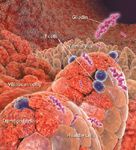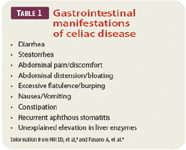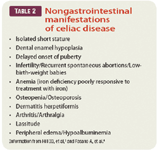Searching for celiac disease: Whom to test and how to test
Celiac disease is one of the most common chronic disorders of mankind and affects 0.5% to 1% of the general population in many countries.

Celiac disease is one of the most common chronic disorders of mankind and affects 0.5% to 1% of the general population in many countries, including the United States.1,2 It is estimated that there are 2 to 3 million people in the United States with CD, and in an average pediatric practice of 1,500 children there are between 5 and 20 children with the condition.1 Most of those with CD remain undiagnosed, and in many other cases the diagnosis is delayed for several years after onset of symptoms.3,4
The main reason for delayed diagnosis is a failure on the part of the health profession to appreciate the protean manifestations of CD and recognize those who are at risk. The discussion here will focus on identifying children who should be tested for CD, choosing the most appropriate serologic test to screen for the condition, and understanding the need to confirm the diagnosis before initiating treatment.


In rare cases, there may be profuse diarrhea with dehydration, electrolyte imbalance, hypoproteinemia, and vascular compromise. This is referred to as a "celiac crisis," which can be life threatening without intensive management.
The classical presentation is relatively less common as an initial presentation of CD in children. More common are gastrointestinal symptoms in the older child or adolescent. These symptoms are variable in both frequency and type and may occur singly or in combination.1,4 Diarrhea can be mild and intermittent, as can abdominal pain or a sensation of bloating.
Constipation that does not respond well to the usual treatment with stool softeners always should raise suspicion for CD. Recurrent aphthous stomatitis, a change in appetite (increased or decreased), unexplained weight loss, or unexplained elevations of liver enzymes all are well-described manifestations of CD.1,4
Among nongastrointestinal manifestations, isolated short stature has been identified as the initial presentation in up to 10% of children referred to an endocrine clinic for evaluation.1 Iron deficiency anemia, often poorly responsive to therapy with supplemental iron, is a well-recognized initial presentation of CD in adults. Iron deficiency anemia frequently is found in children who are diagnosed with CD but is less frequently recognized as an initial presentation in the pediatric age group.
Delayed onset of puberty can affect both boys and girls, and infertility, recurrent spontaneous abortions, and delivery of low-birth-weight babies can affect women of childbearing age.1,4,5 Dermatitis herpetiformis, characterized by a pruritic papular eruption over the extensor surfaces around the elbows, knees, and buttocks, with a characteristic subepithelial deposit of immunoglobulin A (IgA) on histology, now is recognized as a skin manifestation of CD.1 It is more common in adults but has been described in children as young as 9 years. Dental enamel hypoplasia, involving the secondary dentition in a symmetric 4-quadrant distribution, also is a characteristic feature of CD that is being increasingly recognized by dentists.1,4